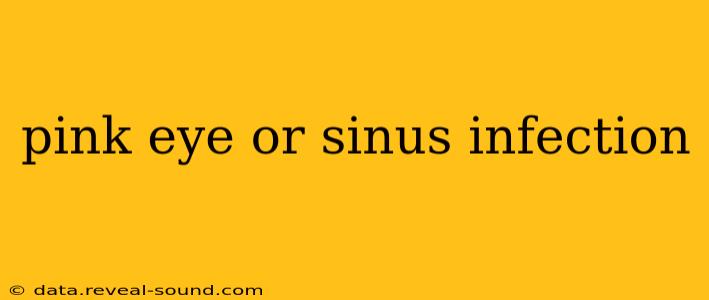Pink eye (conjunctivitis) and sinus infections (sinusitis) are common ailments, but they affect different parts of the body and have distinct symptoms. While they can sometimes occur simultaneously, understanding their differences is crucial for proper diagnosis and treatment. This article will help you differentiate between pink eye and a sinus infection, answering common questions along the way.
What is Pink Eye (Conjunctivitis)?
Pink eye is an inflammation or infection of the conjunctiva, the membrane lining the inside of your eyelids and covering the white part of your eye. It's characterized by redness, itchiness, and often a watery or discharge. Several things can cause pink eye, including:
- Viral infections: The most common cause, often associated with other cold symptoms.
- Bacterial infections: Treatable with antibiotic eye drops or ointments.
- Allergic reactions: Triggered by pollen, dust, or other allergens.
Key Symptoms of Pink Eye:
- Redness: The whites of the eyes become noticeably red.
- Itching: Often intense and uncomfortable.
- Discharge: Watery, mucus-like, or pus-like, depending on the cause.
- Crusting: Especially noticeable upon waking up.
- Swollen eyelids: In some cases.
- Sensitivity to light (photophobia): May be present.
What is a Sinus Infection (Sinusitis)?
A sinus infection is an inflammation of the sinuses, air-filled spaces behind your forehead, cheeks, and nose. These infections typically occur when the sinuses become blocked, leading to the buildup of mucus and bacterial growth. Sinusitis can be acute (lasting less than four weeks) or chronic (lasting longer than 12 weeks). Common causes include:
- Viral infections: Often a complication of a cold or flu.
- Bacterial infections: Require antibiotic treatment.
- Fungal infections: Less common but can be severe.
- Allergies: Can contribute to inflammation and blockage.
Key Symptoms of a Sinus Infection:
- Facial pain or pressure: Often described as a dull ache or throbbing in the forehead, cheeks, or between the eyes.
- Congestion: Stuffy nose and difficulty breathing through the nose.
- Thick, discolored mucus: Yellow or green mucus is a common sign of bacterial infection.
- Fever: May be present, especially with a bacterial infection.
- Cough: Often a persistent, sometimes productive cough.
- Fatigue: Feeling tired and unwell.
- Reduced sense of smell (anosmia): Temporary loss of smell.
How Can I Tell if I Have Pink Eye or a Sinus Infection?
The key difference lies in the location of the symptoms. Pink eye affects the eyes, while a sinus infection affects the sinuses and often presents with facial pain and pressure. However, some symptoms can overlap. For instance, both can cause congestion and a runny nose.
It's essential to see a doctor for a proper diagnosis. They can perform a physical examination and, if necessary, order tests to determine the cause and appropriate treatment. Self-treating can worsen the condition.
Can You Have Pink Eye and a Sinus Infection at the Same Time?
Yes, it's possible to have both pink eye and a sinus infection concurrently. This is often because both conditions are frequently caused by viral or bacterial infections, which can spread throughout the body. If you experience symptoms suggesting both conditions, consult a healthcare professional for accurate diagnosis and appropriate treatment.
What are the Treatments for Pink Eye and Sinus Infections?
Treatment depends on the underlying cause.
Pink Eye:
- Viral Pink Eye: Usually resolves on its own within a week or two. Treatment focuses on managing symptoms with cool compresses and lubricating eye drops.
- Bacterial Pink Eye: Treated with antibiotic eye drops or ointment.
- Allergic Pink Eye: Managed with antihistamine eye drops or oral antihistamines.
Sinus Infection:
- Viral Sinus Infection: Usually resolves on its own, with treatment focused on relieving symptoms (decongestants, saline nasal spray, pain relievers).
- Bacterial Sinus Infection: Treated with antibiotics.
- Fungal Sinus Infection: Requires more aggressive treatment, often involving antifungal medications.
Always consult a doctor before starting any treatment.
When Should I See a Doctor?
You should seek medical attention if:
- Your symptoms are severe or worsening.
- You have visual changes or impaired vision.
- You have a fever.
- Your symptoms don't improve after a week or two of self-care.
- You suspect you have a bacterial infection.
This information is for general knowledge and does not substitute professional medical advice. Always consult a healthcare professional for diagnosis and treatment of pink eye or a sinus infection.
